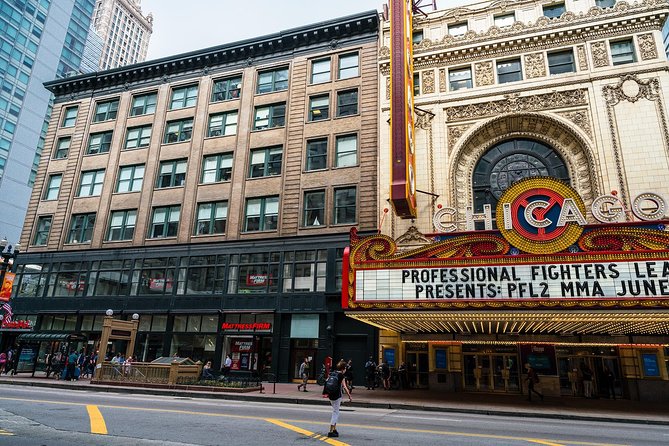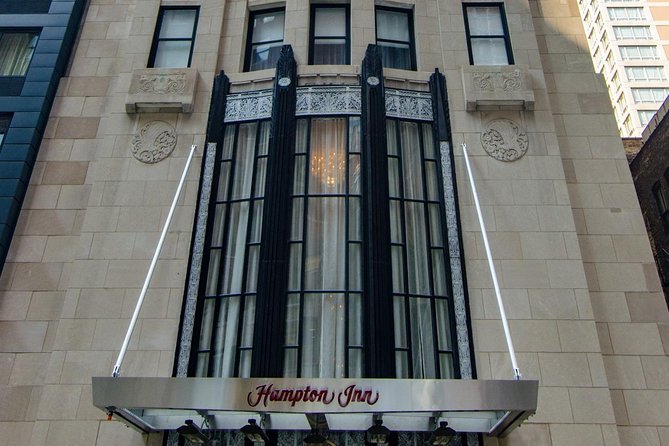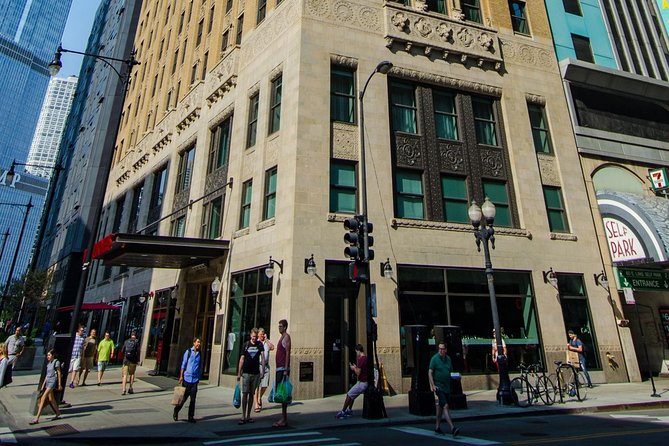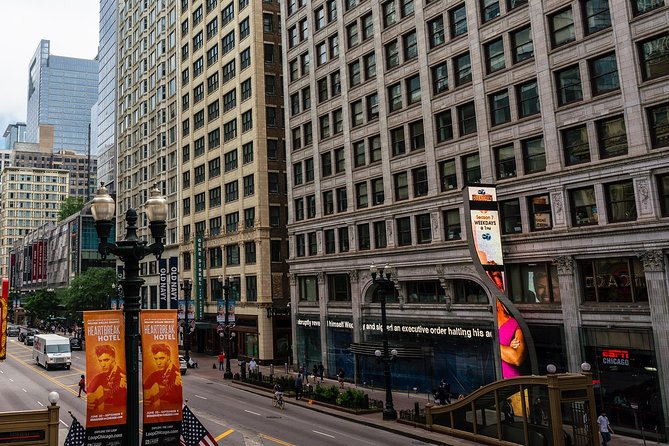Set out on a captivating journey through the architectural wonders of Chicago with the Chicago Walking Tour: A Walk Through Time.
This unique experience allows visitors to explore the city’s rich history and witness its evolution through its iconic buildings.
Led by knowledgeable guides, you will uncover the stories behind Chicago’s renowned skyscrapers and architectural gems, gaining insights into their innovative designs, historical significance, and cultural impact.
From the city’s early architectural gems to the rise of skyscrapers, and from the evolution of Art Deco and Modernism to the unveiling of postmodern and contemporary designs, this tour promises to be an unforgettable exploration of Chicago’s architectural future.
So, step into the world of Chicago’s architectural legacy and discover the hidden tales that shape its stunning skyline.
This experience made our list of the 20 Best Walking Tours In Chicago.
Good To Know

- Chicago’s architectural history dates back to the 19th century and was greatly influenced by the Great Chicago Fire of 1871.
- Prominent architects like Louis Sullivan and Frank Lloyd Wright played a significant role in shaping Chicago’s architectural landscape.
- Chicago is known for its iconic skyscrapers, including the Willis Tower, Tribune Tower, John Hancock Center, and Aqua Tower.
- The city is a leader in sustainable architecture and green building practices, with initiatives such as the Chicago Green Roof Program and LEED certification system.
Meeting Point and Starting Time

The meeting point for the Chicago walking tour is conveniently located near the intersection of Michigan and Wacker, making it easily accessible for participants. This central location allows visitors to easily navigate to the starting point and begin their architectural exploration of the city.
The tour typically starts at 10:00 AM, allowing participants to enjoy a leisurely morning before embarking on their journey through Chicago’s architectural history. It’s important for participants to arrive on time to ensure a smooth start to the tour.
The knowledgeable guide will meet the group at the designated meeting point and provide a brief introduction before setting off on the walking tour. With the meeting point’s convenient location and the tour’s punctual starting time, participants can begin their adventure into Chicago’s architectural wonders with ease and excitement.
Interested in exploring Chicago on foot? Other walking tours we've covered
Exploring Chicago’s Early Architectural Gems

Embarking on an architectural journey through the Windy City, participants of the Chicago walking tour are transported back in time to explore the early gems that shaped the city’s skyline.
Led by knowledgeable guides, visitors explore the rich history of Chicago’s architectural pioneers and discover iconic landmarks that have become synonymous with the city’s identity.
From the elegant simplicity of Louis Sullivan’s Carson Pirie Scott Building to the grandeur of Daniel Burnham’s Monadnock Building, each stop on the tour offers a glimpse into the vision and craftsmanship of these early architects.
As participants walk the streets of Chicago, they can’t help but be captivated by the intricate details and innovative designs that have made these buildings enduring symbols of the city’s architectural legacy.
The Rise of Skyscrapers in the Windy City

With the city’s rich architectural history as a backdrop, the Chicago walking tour delves into the captivating tale of the rise of skyscrapers in the Windy City. Chicago’s skyline has been shaped by the impact of technology on skyscraper construction and the influential work of architects like Frank Lloyd Wright.
Technological advancements played a crucial role in the development of skyscrapers in Chicago. The invention of steel-frame construction allowed for taller and more structurally sound buildings. The use of elevators and improved building materials further revolutionized the construction process.
One architect who left a lasting mark on Chicago’s skyline was Frank Lloyd Wright. Known for his innovative designs, Wright’s influence can be seen in the city’s architecture. His organic approach to design, characterized by open spaces and natural materials, challenged traditional notions of skyscraper construction and inspired future architects.
As you explore the Windy City on this walking tour, you’ll witness firsthand the incredible impact of technology and the enduring influence of Frank Lloyd Wright on Chicago’s architectural landscape.
Art Deco and Modernism: Chicago’s Architectural Evolution
Chicago’s architectural landscape underwent a transformative evolution during the era of Art Deco and Modernism, leaving an indelible mark on the city’s skyline. Influenced by various architectural styles, Chicago became a hub for innovative design and construction. The city’s architectural influences ranged from the classical Beaux-Arts style to the sleek and futuristic International Style.
Iconic Art Deco buildings such as the Chicago Board of Trade Building and the Carbide & Carbon Building showcased the city’s commitment to modernity and elegance. These structures, with their bold geometric shapes and decorative motifs, became symbols of Chicago’s architectural prowess.
Along With Art Deco, Modernism played a significant role in shaping Chicago’s architectural evolution. The iconic Willis Tower, formerly known as the Sears Tower, stands as a testament to the city’s embrace of sleek, functional design. With its innovative structural system and towering height, it became a symbol of Chicago’s ambition and progress.
Chicago’s architectural landscape continues to evolve, with new buildings blending elements of the past with cutting-edge design. The city’s commitment to architectural excellence remains steadfast, ensuring that its skyline will always be a showcase of innovation and beauty.
Discovering Postmodern and Contemporary Designs
Continuing the journey through Chicago’s architectural evolution, the focus now shifts to the exploration of postmodern and contemporary designs that have shaped the city’s skyline.
Postmodern architecture, characterized by its playful and eclectic style, emerged in the late 20th century as a reaction against the strict rules of modernism. It often incorporates elements of historical styles, as well as whimsical and unconventional design elements. Some notable postmodern buildings in Chicago include the Harold Washington Library Center, with its unique geometric facade, and the Thompson Center, known for its curved glass exterior and vibrant colors.
Along With postmodern architecture, the city also boasts numerous contemporary designs that push the boundaries of architectural innovation. These buildings blend sleek lines, innovative materials, and sustainable features to create stunning and environmentally-conscious structures that redefine the urban landscape.
Unveiling Chicago’s Architectural Future
As we look ahead to the future of Chicago’s architecture, new and exciting designs promise to shape the city’s skyline with innovation, sustainability, and cutting-edge aesthetics. Here are some key highlights of the unveiling innovative designs and sustainable architecture that are set to transform Chicago:
Green Roofs: Chicago is embracing the concept of green roofs, where vegetation is integrated into the building’s design. These roofs not only provide a visually appealing element but also help reduce stormwater runoff and improve air quality.
Net Zero Buildings: The city is striving to achieve net-zero energy consumption in buildings by implementing advanced technologies and design strategies. These buildings generate as much energy as they consume, resulting in reduced carbon emissions and a more sustainable future.
Adaptive Reuse: Chicago is embracing adaptive reuse, transforming old industrial buildings and warehouses into modern, sustainable spaces. This approach not only preserves the city’s architectural heritage but also reduces waste and promotes sustainability.
Vertical Gardens: Vertical gardens are gaining popularity in Chicago, adding a touch of nature to the urban landscape. These living walls not only enhance the aesthetics of buildings but also help improve air quality and provide insulation, contributing to a greener city.
Smart Buildings: Chicago is at the forefront of smart building technology, integrating advanced systems and sensors to optimize energy usage and enhance occupant comfort. These intelligent buildings use data and automation to improve efficiency and sustainability.
With these innovative designs and sustainable practices, Chicago is poised to be a leader in shaping the future of architecture, creating a city that isn’t only visually stunning but also environmentally conscious.
Common Questions
How Long Does the Chicago Walking Tour: a Walk Through Time Typically Take?
The Chicago Walking Tour: A Walk Through Time typically takes around 2 hours. It covers the city’s most famous buildings in chronological order and provides in-depth commentary on Chicago’s architectural history.
Are There Any Breaks or Rest Stops During the Walking Tour?
Yes, there are breaks and rest stops during the walking tour, making it accessible for individuals with mobility issues. This allows participants to take a break, rest, and fully enjoy the tour.
Is the Walking Tour Suitable for Individuals With Mobility Issues?
The walking tour provides alternative options for individuals with mobility issues. Accessibility concerns are addressed by offering a virtual tour option. This allows everyone to enjoy the tour and learn about Chicago’s architectural history.
Can Children Participate in the Chicago Walking Tour: a Walk Through Time?
Children of all ages can participate in the Chicago Walking Tour: A Walk Through Time. There are no age restrictions, making it a family-friendly activity. They can learn about the city’s architectural history while enjoying a leisurely walk through Chicago’s famous buildings.
Are There Any Specific Clothing or Footwear Requirements for the Walking Tour?
There are no specific clothing or footwear requirements for the walking tour. However, it is recommended to wear comfortable shoes and dress appropriately for the weather, as the tour covers a significant distance.
The Sum Up
To sum it up, the Chicago Walking Tour: A Walk Through Time offers a captivating journey through the architectural history of Chicago.
With knowledgeable guides and a chronological exploration of iconic buildings, participants are treated to fascinating insights into the city’s growth and development.
From early architectural gems to the rise of skyscrapers, the tour showcases the innovative designs and cultural impact of each building.
Whether you’re a history enthusiast or simply curious about Chicago’s unique skyline, this tour promises an unforgettable experience.
More Walking Tours in Chicago
- Best of Chicago: Private Walking Tour with a Local
- Chicago: Art of a City, Downtown Chicago Guided Walking Tour
- Chicago: Architecture and Engineering Marvels Walking Tour
- Chicago: Art Deco Madness Walking Tour
- Chicago: Food and Culture Walking Tour
- Chicago Downtown Walking Tour & Lake Michigan Cruise Tickets
More Tours in Chicago
- 1-Day Tour Lake Geneva & Anderson Japanese Gardens
- Best of Chicago: Private Walking Tour with a Local
- Chicago: 360 CHICAGO & Hop-on Hop-off Bus Tour (Save 20%)
- Chicago: Art of a City, Downtown Chicago Guided Walking Tour
- Chicago: Architecture River Tour and Hop-on Hop-off Bus Tour
- Chicago: Architecture Boat Tour with Drinks
More Tour Reviews in Chicago
Looking for something different? Other Chicago activities we've written about
- 1-Day Tour Lake Geneva & Anderson Japanese Gardens
- Best of Chicago: Private Walking Tour with a Local
- Chicago: 360 CHICAGO & Hop-on Hop-off Bus Tour (Save 20%)
- Chicago: 2-Hour Kayak Rental from Bridgeport
- Chicago: 2-Hour Downtown Kayak Rental
- Chicago: 1-5 Day Attraction Pass with Shedd Aquarium
- Chicago by Night River and Lake Cruise
- Chicago: Art of a City, Downtown Chicago Guided Walking Tour
- Chicago: Architecture River Tour and Hop-on Hop-off Bus Tour
- Chicago: Architecture Boat Tour with Drinks
- Chicago: Architecture and Engineering Marvels Walking Tour
- Chicago: Art Deco Madness Walking Tour
